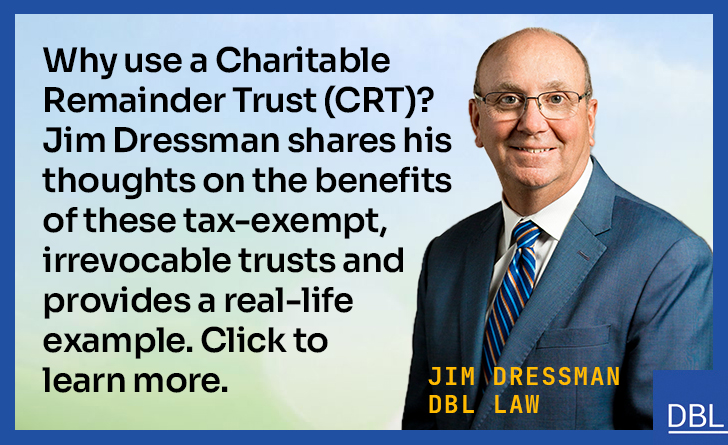A Charitable Remainder Trust (CRT) is an irrevocable tax-exempt trust providing an income stream to non-charitable beneficiaries for life or a determined period of time with the remainder going to charities (“split-interest trust”). The primary benefits of a CRT, besides supporting qualifying charities, are twofold: a) tax avoidance (there is a charitable deduction upon contribution of assets to trust and no taxable gain by an exempt trust on the sale of appreciated assets) and b) there is an increased income stream from liquidated assets since no income taxes are due upon sale.
Typically, a grantor donates appreciated assets to a property drafted CRT. Appreciated real estate is the most commonly used asset. The transfer to the CRT must occur before all significant contingencies to completion of sale are satisfied. The CRT then completes a sale of the appreciated assets.
A CRT is irrevocable, but a CRT can allow the grantor to change trustees and to change charitable beneficiaries because the remainder is not paid out to a qualifying charity until the death of the last surviving non-charitable beneficiary. Many will designate a donor advised fund as the charitable beneficiary to allow the grantor’s heirs or other designee to select a benefiting charity. The CRT must provide for periodic payments to non-charitable beneficiaries in one of the following manners: 1) an annuity with fixed a percentage of assets valued when the trust is established that cannot be less than 5% or more than 50% but can be for life or a fixed term; or, 2) a unitrust with a fixed percentage of trust assets valued annually that cannot be less than 5% or more than 50%. There are also other options for the distributions to non-charitable beneficiaries such as Net Income Plus Make-Up Unitrust (NIMCRUT), Net Income Only Unitrust, and FLIP Unitrust which functions as a NIMCRUT until a trigger (sale of real estate) or date “flips” to a standard unitrust.
Normally the non-charitable beneficiaries are the Grantor and spouse. Alternatives can be a child or other relative. If the CRT is for a term of years, the donor can establish a “class” of beneficiaries such as grandchildren.
The Grantor can be the Trustee, but it is not advisable if assets are not marketable securities with clear, ascertainable values. The Grantor can start with an institutional trustee, and change to the Grantor once all valuation issues are resolved.
REAL-LIFE EXAMPLE
The owner of an LLC which owns a rental office building intends to sell the building. The owner is 67 and his wife is 67. He gives the LLC membership interest to a CRT before the sale contract is signed. The office building is sold, and the CRT’s share of the proceeds is $540,000. The owner had a tax basis of zero. He actually had a negative capital account. The net to the owner without the CRT would have been $384.480, after paying $128,000 in federal tax (23.8%) and $27,000 Kentucky tax (5%). At 6%, the annual earnings would have been $23,069. With the CRT, there was net sale proceeds of $540,000 with no tax due. At 6% the annual earnings are $32,400 and, in addition, the owner received a charitable deduction of $158,000.


